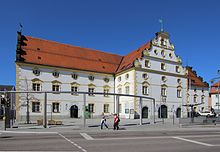Kornhaus (Kempten)
The Kornhaus in Kempten (Allgäu) is a striking, baroque building in the former abbey town of Kempten . It was built according to the plans of Johann Jakob Herkomer . The cross-shaped building with the address Großer Kornhausplatz 1 was used for grain storage . Today the building houses a ballroom and the Allgäu Museum .
history
Rupert von Bodman commissioned the construction of the granary, whereupon Johann Jakob Herkomer made the plans. After completion after 1700 rye, barley and grain were traded and listed in the Kornhaus. In 1803 the building was transferred to the Kingdom of Bavaria due to secularization . This gradually caused the building to deteriorate. From 1893 the grain was also stored in the town hall's granary . With that, the building lost its purpose.
It was acquired in 1872 by the city of Kempten, which set up a spacious ballroom in it in 1874/75. After the First World War , the butter and cheese exchange was established in the south wing in 1923. The Allgäu local history museum was set up in the north wing in 1925. The weekly market moved into the vaulted cellar every winter.
The Kornhaus is registered as an architectural monument in the Bavarian Monument List.
The last weekly market in the Kornhaus took place in 1998. The following year the new market hall on Königsplatz was opened for this purpose. A general renovation took place in 1998. In addition to its function as a city and regional museum, it has since served as a location for events such as concerts, plays and conferences. The renovation of the building has been ongoing since the end of 2018.
Building description
Above the main portal is the coat of arms of Prince Abbot Rupert von Bodman . The interior has been changed several times over the course of history. A large ballroom was set up from 1874 to 1876. The mighty three-storey building is cross-shaped and has curved volute gables . It is illuminated through rectangular, horizontal and vertical oval windows. There are three arched openings in the middle section.
Allgäu Museum
history
The Allgäu-Museum (also AllgäuMuseum ) was opened in 1999 in the Kornhaus. The museum was closed at the end of November 2018. Some of the exhibits will be shown in the new Kempten Museum in the Zumsteinhaus , which opened on December 6th to 8th, 2019. A new Allgäu Museum is then to be built in the Marstall . The Kornhaus has been renovated since the museum moved out and is intended to serve purely as an event venue in the future.
exhibition
The tour began with a journey through time through the history of Kempten from the present back to the early Middle Ages. Among other things, portraits of prince abbots and patricians, princely splendor and handicraft from a time when Kempten was still divided into a Catholic collegiate city and a Protestant imperial city were shown. Gothic dragon chandeliers were exhibited as well as unique finds from everyday medieval life.
The Views into Allgäu department presented colorful faience, souvenirs, traditional hats, products from various glassworks, cow bells, alpine jewelry and a specially built "drawer cow".
City life dealt with the work and leisure of the urban population in the 19th century. There were u. a. a "parlor" from the Biedermeier period, portraits of citizens, toys, tobacco utensils, clothing, canes and hats, furniture and the court pharmacy are presented. In addition, a perforated board slot machine from an inn could be made to sound with the help of a coin.
The life of the rural population was also dealt with in the Allgäu Museum. Flax processing equipment and dairy equipment illustrated two of the most important rural work areas of the past 150 years. A conversation between a maid and a day laborer could be overheard in a farm room. Rosaries coffin crowns , Infant Jesus or devotional paintings occupied the diverse expressions of popular piety. In addition, an annual nativity scene made between 1820 and 1843 and consisting of over 250 figures by the Kempten carver Ludwig Weiß was shown.
Under the motto "time is money", tower and picture clocks, a treasure of gold buried in the 17th century, zappers and other clocks together with gold scales, money chests, thalers and lumps were exhibited in the last exhibition unit .
Juggling balls from the 15th / 16th centuries Century, find from the Mühlberg ensemble
GEHA light motorcycle from 1926
Individual evidence
- ↑ a b c City of Kempten (ed.): The granary in Kempten. In: Youtube , December 9, 2011, Kempten (accessed June 11, 2012).
- ^ Josef Rottenkolber: The history of the city of Kempten . Ed .: Josef Rottenkolber. Tobias Dannheimer, Kempten 1935, p. 85 .
- ↑ List of monuments for Kempten (PDF) at the Bavarian State Office for Monument Preservation, monument number D-7-63-000-81
- ^ A b Michael Petzet : City and District of Kempten. (= Bavarian art monuments. Vol. 5), 1st edition. Deutscher Kunstverlag, Munich 1959, DNB 453751636 , p. 38f.
- ^ Georg Dehio : Handbook of German Art Monuments - Bavaria III - Swabia . 2nd Edition. Deutscher Kunstverlag, Munich-Berlin 2008, ISBN 978-3-422-03116-6 , pp. 573 .
- ↑ Christine Tröger: Kornhaus should have had its day as a museum from 2019. Kreisbote, October 16, 2016, accessed on February 7, 2017 .
Web links
Coordinates: 47 ° 43 ′ 43.5 ″ N , 10 ° 18 ′ 35.1 ″ E





